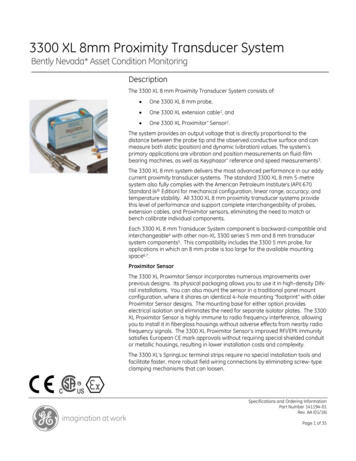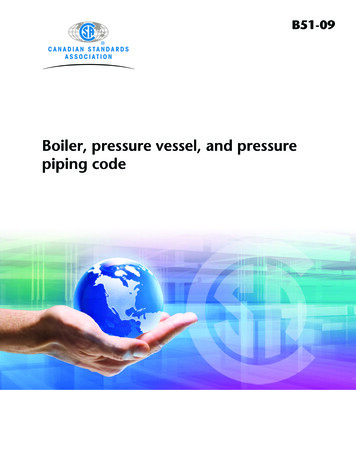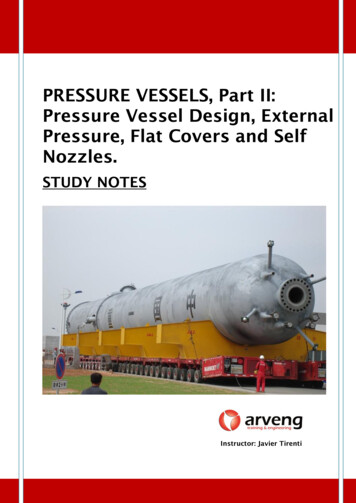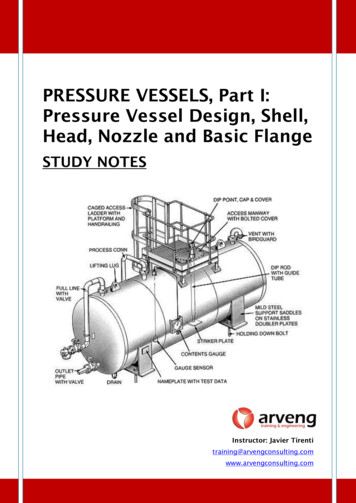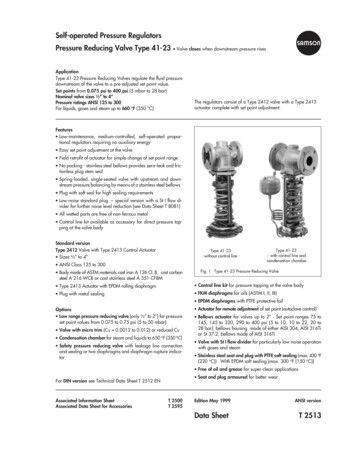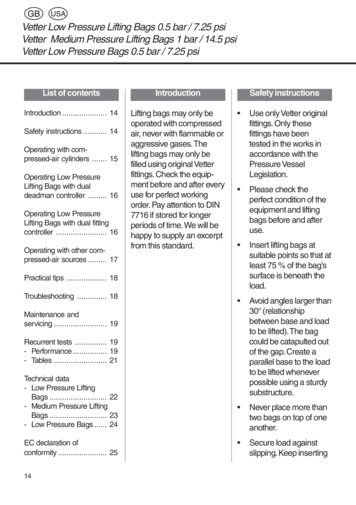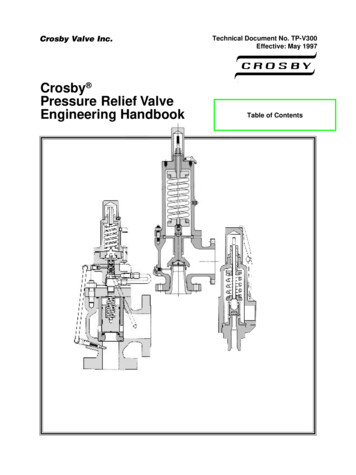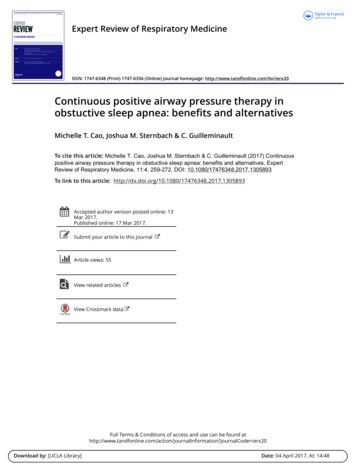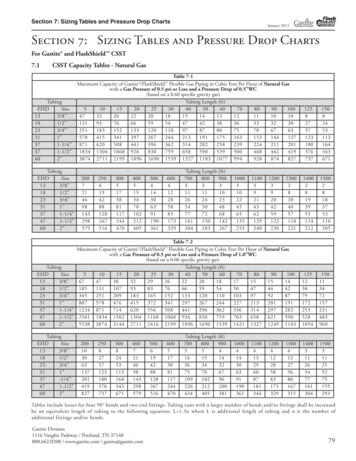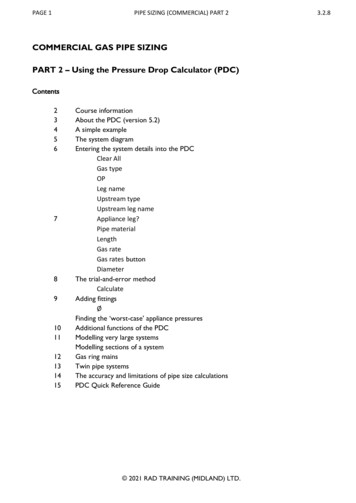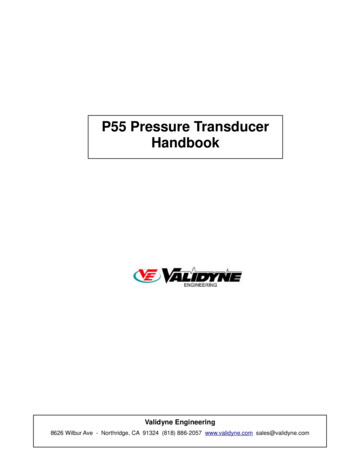
Transcription
P55 Pressure TransducerHandbookValidyne Engineering8626 Wilbur Ave - Northridge, CA 91324 (818) 886-2057 www.validyne.com sales@validyne.com
P55 HandbookTable of ContentsP55 Data Sheet . 3General Operating Instructions . 7Sample P55 Calibration Data Sheet . 9Outline Drawing .11Wiring Diagrams . 12Calibration Procedure . 13Protecting Against Hot Fluids – Temperature Isolation . 17Bench Testing the P55Calibration .19Definition of P55 Specifications . 23.Returning a P55 for Repair .32
Model P55Differential Pressure TransmitterFeatures: Small, Rugged DP Transmitter for Liquid Service /-5 Vdc or 4-20 mA Two-Wire OutputFull Scale Range from 2.22” H2O to 3200 psiExcellent Temperature Characteristics0.25% Accuracy – 0.1% Accuracy OptionalThe Validyne Model P55 is a compactdifferential pressure transmitter designed forindustrial measurement applications. Thevariable reluctance sensing technology allowsthe P55 to be used in a wide variety of lowpressure measurements where fast dynamicresponse, high resistance to vibration andsuperior signal stability through ambienttemperature change is required. The P55 willaccept both gases and liquids directly at thesensing diaphragm; there are no internalisolation fluids to slow the sensor response orcause excessive temperature shift errors.The P55 is available in three outputconfigurations: 4-20 mA current sink output, DCoutput and isolated DC output. The 4-20 mAoutput version is a true two-wire system whichwill operate over a supply voltage of 9 to 55Vdc.The DC version is a direct replacement for theVdc signal. The isolated DC output versionprovides the same /-5 Vdc signal, isolatedfrom the power supply by 100 MOhmsThe P55 is also available in an absolutepressure version with a welded variablereluctance sensor. Zero and span controlsare available for external adjustment, andthe wiring may be via connector or pigtailoptions.The P55 is Ideal for: Level MeasurementsHydraulic SystemsVehicle Testing8626 Wilbur Avenue - Northridge, CA 91324 - Voice: 818-886-2057 - Fax: 818-886-6512Website: www.validyne.com - E-Mail: sales@validyne.com
P55 SpecificationsGeneral Specifications –Sensor Physical Specifications -Ranges:Pressure Media:Liquids & gases compatiblewith 410 SST and InconelO-Rings:Buna-N Standard, othercompounds availableP55D: /-0.08 psid to /-3200 psidP55A: 0 - 0.08 psia to 0 - 3200 psiaAccuracy:P55D: /-0.25% FS, includesnon-linearity, hysteresisand non-repeatabilityP55E: /-0.1% FS. as aboveP55A: /-0.5% FS, as abovePressure Cavity Volume:4 e-3 cu in, each portVolumetric Displacement:3 e-4 cu in at FSWeight:16 Oz.Overpressure:P55D: 200% FS up to 4000 psimaximum with less than0.5% FS output shiftP55A: 20 psia or 200% FS,whichever is greater, up to4000 psia maximum, forless than 0.5% zero shiftPower Requirements -P55D: 3200 psig maximum, withzero shift less than 1%/KpsiSignal Output -Power Supply:9 to 55 Vdc, unregulatedCurrent Draw:4-20 mA Output: /-5 Vdc Versions:25 mA max3 mA, typLine Pressure:Pressure Ports:P55D: 1/8" female NPT with 8-32Bleed Screw & Gasket, STDP55A: 5/16-24 UNF-2B with 1/8"male NPT adapter included4-20 mA Output:DC Voltage Output:Zero Balance:Span:4 to 20 mA /-5 Vdc @ 0.5 mABy external adjustmentBy external adjustmentFrequency Response: Low Pass Filter at 250 Hz, -3 dbEnvironmental Specifications Operating Temp:Compensated Temp: 0 to 160 F-65F to 250 F (Optional)Temperature Errors:Line Regulation:0.02%Output Noise:2 mVrms-65 F to 250 FInsulation Resistance: 100 MOhms, any terminal tocase /-0.5% FSFor Operating TemperatureRange of 0 F to 160 F /-0.9% FSFor Operating TemperatureRange of -65 F to 250 FIncludes non-linearity andhysteresis errors8626 Wilbur Avenue - Northridge, CA 91324 - Voice: 818-886-2057 - Fax: 818-886-6512Website: www.validyne.com - E-Mail: sales@validyne.com
Ordering InformationWiring Diagram
8626 Wilbur Avenue - Northridge, CA 91324 - Voice: 818-886-2057 - Fax: 818-886-6512Website: www.validyne.com - E-Mail: sales@validyne.com
Operating Instructions forDC Voltage Output TransducersI. INTRODUCTIONDC Output Pressure Transducers combine a rugged andreliable variable reluctance pressure sensor with a solid statecarrier demodulator, yielding a DC-DC transducer capable ofoperating from an unregulated power supply and providing aproportional analog output signal.Differential and gage versions feature symmetrical pressurecavities with only corrosion resistant materials and O-ringcavity seals in contact with the pressure media. Absoluteversions feature all-welded stainless steel construction andare not field serviceable. Both versions provide internaladjustments for Zero and output Span.II. UNPACKINGTransducers are shipped with plastic caps, plugs or adhesivestickers over the pressure ports. These prevent dirt fromentering the pressure cavities. It is recommended that thecovers be left on the ports until making pressure connections.On very low range units, the port covers may have a smallhole in them. This is done to eliminate internal pressurescaused by installing the cover. Be sure to check the shippingcarton thoroughly for any accessory items – pressure fittingadapters, mating connectors, etc. – that may have beenordered. A pressure fitting adapter with O-ring seal is alsoprovided with absolute versions.III. INSTALLATIONProper installation of a transducer is important but notdifficult. This section covers a few guidelines regardingmounting, pressure connections, plumbing, liquid-filling (or“bleeding”) and electrical connections which, when observed,will go a long way toward assuring the success of themeasurement.Mounting. An integral plate with four holes is provided formounting on a flat surface (See Figure 1 for details). Toprevent strains on the tubing connections, the absoluteversion, or the differential version with fitting adapters for usewith tubing systems, should be mounted using the integralplate. The differential version with two 1/8-27 NPT female pipeports may be mounted by rigid pipe connections.To prevent strain on the transducer body, the integral plateshould be mounted on a flat surface. Such strain can causesmall zero shifts that can be accentuated by temperaturechanges.Mounting the transducer above the point of measurement willminimize accumulation of dirt or condensate, enhancing theinternal cleanliness of the transducer. Finally, be sure toprovide access to the electrical connector and bleed ports.Plumbing. Plumbing should allow transducer removal and reinstallation without shutdown of the pressure system. If thetransducer is used for gage pressure measurement where oneport is left open to the atmosphere, a simple shutoff valve canbe installed in the line to the transducer. The open (reference)port should be covered by a porous filter to prevent access ofdirt and dust (use a plastic cap with a small hole). Non-porousplugs are not recommended; the relatively small volume of airin the reference cavity will severely damp transducer responseand substantially increase temperature error.A differential pressure transducer used to measure thepressure drop across an orifice or filter requires moreextensive valving not only to place it into operation but also toremove it without overpressure damage. In this case a valvearrangement as shown in Figure 2 should be used.FIGURE 1. Outline/Installation Drawing
Otherwise the trapped gas acts as a pneumatic damper andcan seriously decrease the frequency response of themeasuring system. To remove entrapped gases, loosen thebleed screw one or two turns with a 5/64" hex wrench, withsystem pressure ON (It is recommended that the bleedscrew not be fully removed as the bleed screw gasket couldbe lost, making an effective seal impossible). After thetrapped gas has been expelled and bubble-free liquid beginsto flow out the vent hole, tighten the bleed screw to seal thecavity. Note that the bleed port vent hole for the negativepressure cavity is covered by the integral (mounting) platewith the transducer normally mounted. If it is necessary toliquid-fill this cavity, it is suggested that the two screws usedto secure the transducer to the base plate be removed toprovide sufficient clearance for the expelled media to exit thevent during the bleed operation.FIGURE 2. Typical Valve Arrangement for DP UseTo pressurize the transducer, close the drain valve and openthe bypass valve. Then both shutoff valves are opened to applyline pressure equally to both sides of the transducer. Finally,close the bypass valve. To remove the transducer, open thebypass valve, close the shutoff valves and open the drain valve.Valve manifolds for this purpose are commercially availablefrom valve and fitting suppliers.Pressure Connections. Pressure connections are made viaports in each cavity. Before making connections to thetransducer, be sure the connecting pipe or fitting is free of looseinternal scale and check the threads for cleanliness or damage.If torn or nicked, clean up the thread with a die or chaser. Thenwrap the tapered thread with two layers of 0.5" wide Teflon pipethread tape (available at most plumbing supply stores),stretching it lightly as it's wrapped so that it conforms to thethreads. Wrap in the direction of the thread, as if screwing on afitting. The Teflon acts as both a thread lubricant and sealant,minimizes thread galling and makes disassembly easier.When attaching the pipe or fitting, screw it in with a smallwrench until it is snug, then, give it another one-half turn. If thethreads are not properly prepared and/or excessive torque isapplied to the tapered thread, the case material around thepressure port can crack from the high tensile stress created.The 5/16-24 port requires a mating fitting adapter with an O-ringto make a leak-free connection. A 5/1 6-24 to 1/8-27 NPT malefitting adapter, with O-ring, is standard.Liquid-Filling ("Bleeding"). A bleed port for each pressurecavity facilitates cleaning or liquid filling of the cavities. Thebleed port is sealed with a set screw machined to carry a glassfilled Teflon gasket at its inner end. The gasket provides thesealing action. For static pressure measurements it is generallyunnecessary to fill the pressure cavity with the liquid media asany trapped air or gas will transmit the pressure to the sensingdiaphragm. However, when good response to dynamicpressure changes or oscillations in liquid-filled systems isimportant, the pressure cavities and transducer connectionsshould be free of gas.Electrical Connections. The standard electrical connectoris a 6-pin PT02A-10-6P (Bendix, or equivalent). Input andoutput connections are as shown on Figure 1. The internalcircuitry is electrically isolated from the transducer case. Ifdesired, the cable shield can be connected to the transducercase through the connector shell. However, if the transduceris grounded through its mounting or through the pressureconnections, the cable shield should be left floating at thetransducer end to eliminate noise from ground currentscirculating through the cable shield.IV. CALIBRATIONAs supplied from the factory, DC transducers have beencalibrated for the full scale pressure and output voltagelevels specified on the purchase order. If desired, thetransducer can be adjusted for other pressure/voltagerelationships, using internal Zero and Span adjustmentsprovided in the electronics module. To determine the rangeof full scale pressures a given transducer may be calibratedto without diaphragm replacement, see the Pressure RangeChart.EQUIPMENT REQUIRED:DC Power SupplyDigital Voltmeter, 0 to 10.OOVdcscale Calibrated Pressure SourcePROCEDURE:A. Connect the transducer to a calibrated pressure sourcecommensurate with the transducer range. For absoluteversions, use a vacuum pump for zero psia input and fullscale ranges less than atmospheric pressure.B. Connect the DC power supply to terminals A ( ) and D (-)of the connector. Set the supply voltage to the voltage to beused at the installation. See the data sheet specification forthe particular unit for power supply voltages.C. Connect the DVM to terminals B ( ) and C (-) of theconnector.D. Apply zero pressure to the transducer, and adjust zeropotentiometer Z for a DVM reading of 001Vdc. (This can beset at any value between 1Vdc). CW rotation causes ( )increases in output.E. Apply full scale pressure to the transducer and adjustpotentiometer S for a DVM reading of 5.00 0.01 Vdc. Thiscan be set at any voltage between 3 and 5.5 Vdc.F. Repeat steps E and F until interaction betweenadjustments is eliminated.
Time: 2:16:36 PMCALIBRATIOlV CERTIFICATESales Order:Work Order: T1572ModelNumber:P55D- 1 - E - 2 - 3 2 - S - 4 - ARange: 2 PSISerial Number: 590263Employee Number: 21 10Pressure Equipment Asset Number: 1375Pressure Equipment Mfg and Model Number: MENSOR PCS-400Pressure Equipment Calibration Due Date: 3191201 1Interface Equipment Asset Number: 1281Interface Equipment Mfg and Model Number: VEC 601Interface Equipment Calibration Due Date: 912812011Ambient Temperature: 68.8 FCalibration Type: 9 Point CalCalibration 000-1.OOO0.000Unit 03-0.01 18626 Wilbur Avenue - Northridge, CA 9 1324-4498Voice: 8 18-886-2057 - Fax: 8 18-886-6512 - Email: sales@validyne.comWebsite: www.validyne.com
Date: 11/24/2010Time: 3:12:20 PMCALIBRATION CERTIFICATESales Order:Work Order: T1572ModelNumber:P55D- 1 - E - 2 - 3 2 - S - 4 - ARange: 2 PSISerial Number: 590259Employee Number: 21 104Initial:Pressure Equipment Asset Number: 1375Pressure Equipment Mfg and Model Number: MENSOR PCS-400Pressure Equipment Calibration Due Date: 3191201 1Interface Equipment Asset Number: 1281Interface Equipment Mfg and Model Number: VEC 601Interface Equipment Calibration Due Date: 91281201 1Ambient Temperature: 69 FCalibration Type: 9 Point CalCalibration 000-1.ooo0.000-Unit 06-0.01 18626 Wilbur Avenue - Northridge, CA 91 324-4498Voice: 818-886-2057 - Fax: 81 8-886-65 12 - Email: sales@validyne.comWebsite: www.validyne.com
OPTION 2-1 & 2VOLTAGE 5 MXl5PRESSIRE PORT FOR P55A (ABSOLUTE MODEL) 5/16-24UNF(5/16 TO 1 / 8 NPT, MALE. ADAPTER FURNISHED)EXCEPT OPTION 8, 'F'. N E E AS S H O W (1/4 O.D. x 1.00 LG)PTlON 2-1 & 2)rOPTION1/ 2 NPT (OPTION 2-SENSOR YATERIbL410 STAINLESS s R410 NICKEL PLAlED454)P"S,l:Ek;":::COPnoNPORT MPES1/8-27NPlF (PORT) & 8-32 BLEEDPRESSURE PORT & BLEED SCREW PCRTBOW 1/8-27 NPlF (410 ONLY)5/16-24 FEMALE PER AN010059-2(FOR ABSOLUlE ONLY)ABEOPrlOnF R W T MEWAA8 - 3 2 BLEED PORT DIM IS .312f.0101/8-27 NPTF BLEED PORT DIM. IS . 2 7 5 f . 0 1 0DIMENSION VARIES WlTH PRESSURE RANGE.NOTES: UNLESS OTHERWISE SPECIFIED.19& ABOE)ISPECIALSI EXTERNAL ACCESS TO Z & S COlAPENSAnONCE APPROED1 3 3 107 v eTOL UNLESS NOTED:CODE IDENT NO.DEC. xxx fo.010FRAC. & OEC. X.XX * 0 2ANUES f l / TDIAMETERS M l H SAME CL SHALL BE CONCENTRIC WlTHlN 0.005 nR.SURFACES MUST BE FLAT MlHlN 0.002 PER INMAX nLLET 0.015 UNLESS NOTEDDEBURR EDGES 0.005 MAX. UNLESS NDTEDSURFACE FINISHUNLESS NOTEDDRILLED HOLE TOL. PER ANOlO387.avSUECK'DTDDASAppyD, DASTITLE1 7/93 lI 1/94 1 MAT'LENGINEERING CORPORATIONNORTHRIDGE. CA!JFORNIA 91324P55PER BOMPER BOMP55OUTLINE DRAWING
P55 Calibration ProcedurePower and Signal ConnectionsThe P55 will come calibrated by the factory for the pressure range specified on your purchaseorder. A calibration sheet will be included showing five pressure/signal points forunidirectional calibrations and 9 pressure/signal points for bidirectional calibrations.The P55 calibration is normally checked and updated at six month intervals. To do this youwill need the following: DC Power Source 9 to 55 Vdc, capable of sourcing 50 mAMulti-meter capable of measuring 0 to /- 5 Vdc and 0 to 25 mAPressure Source capable of providing full scale pressure to within 0.05%Verify the output version from the model number on the nameplate and the data sheet:Voltage output versions will have 1, 2, 3, 6, 7 or 8 in the Calibrated Output specifierCurrent output versions will have 4 or 5 in the Calibrated Output specifier
Wire for Power and SignalFirst, wire the P55 for power and signal as shown below (voltage output version):If you have a 4-20 mA current output P55, wire as shown:With the power applied, but mo pressure connected to the sensor, note the output reading. Itshould be very close to 0.000 /-0.005 Vdc for the voltage output versions (-1, -2, -7 or -8),and 4.000, /-0.005 mA for the current output versions (-4 ). For offset voltage outputversions (-3, -7) the output should be 2.500, /- 0.005 Vdc. For offset current output versions(-5), the signal should be 12.000, /-0.005 mA at zero pressure on the transducer.
Zero and Span Adjustment LocationsNotice on the rear of the P55, by the electrical connector, there are two screw-driveradjustments. One is marked Z for zero adjustment and one marked S for Span adjustments.Zero AdjustmentWith zero differential pressure applied to the transducer (both ports open to atmosphere), turnthe Zero adjustment until the correct zero pressure signal is attained. The correct signal willdepend on the output version you have (see model number information above).For output versions -1, -2, -6 and -7, the correct zero signal is 0.000 Vdc, /-0.005 VdcFor output versions -3 and -8, the correct zero signal is 2.500 Vdc, /-0.005 VdcFor output version -4, the correct zero signal is 4.000 mA, /-0.005 mAFor output version -5, the correct zero signal is 12.000 mA, /-0.005 mASpan AdjustmentWith full scale pressure applied to the pressure port, turn the S adjustment for the correctfull scale output signal.For output versions -1, -2, -3, -6, -7 and -8, the correct FS signal is 5.000 Vdc, /-0.005 VdcFor output version -4 and -5, the correct FS signal is 20.00 mA, /-0.005 mAIf you have a unidirectional P55 (-1, -6 or -4) proceed to Checking for Accuracy.
For bidirectional transducers (-2, -3, -5, -7 and -8), apply the full scale pressure to the –pressure port and observe the output signal.For output versions -2 and -7, the correct -FS signal is -5.000 Vdc, /-0.005 VdcFor output versions -3 and -8, the correct -FS signal is 0.000 Vdc, /-0.005 VdcFor output version -5, the correct -FS signal is 4.000 mA, /-0.005 mAThe Span adjustment may need to be tweaked slightly to achieve a balanced output at both and – full scale.The outputs should be re-checked at zero pressure and the Zero adjustment tweakedaccordingly.Checking for AccuracyThe P55 should calibrate such that the maximum error is 0.25% of full scale from a best-fitline to zero, mid-scale, full scale, mid-scale and zero pressure readings (unidirectional). Forbi-directional versions the pressure readings are additionally taken at – mid-scale, -full scale,-mid-scale and zero (a total of 9 points).Spreadsheets for both unidirectional and bidirectional output versions are available so that allthe calculations for accuracy are included.See the Validyne website for details.
Temperature Isolation of Pressure SensorsFrequently it is necessary to measure the pressure of fluids which at temperatures aboveor below the ratied operating range of the available pressure transducers. The expense ofa special transducer can often be avoided if the pressure sensor is isolat
P55 Pressure Transducer Handbook Validyne Engineering 8626 Wilbur Ave - Northridge, CA 91324 (818) 886-2057 www.
